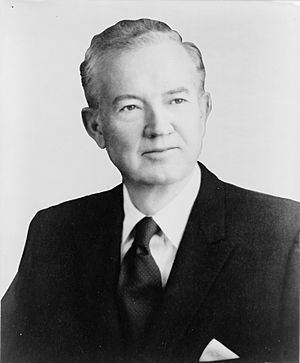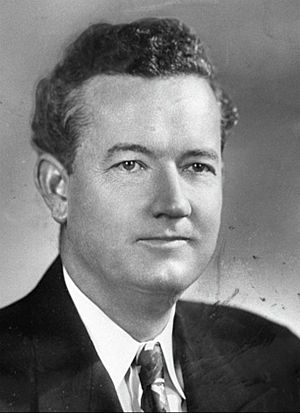John Sparkman facts for kids
Quick facts for kids
John Sparkman
|
|
|---|---|
 |
|
| Chairman of the Senate Committee on Foreign Relations | |
| In office January 3, 1975 – January 3, 1979 |
|
| Preceded by | J. William Fulbright |
| Succeeded by | Frank Church |
| Chairman of the Senate Committee on Banking, Housing, and Urban Affairs | |
| In office January 3, 1967 – January 3, 1975 |
|
| Preceded by | A. Willis Robertson |
| Succeeded by | William Proxmire |
| Chairman of the Senate Select Committee on Small Business | |
| In office January 3, 1955 – January 3, 1967 |
|
| Preceded by | Edward John Thye |
| Succeeded by | George Smathers |
| In office February 20, 1950 – January 3, 1953 |
|
| Preceded by | Edward John Thye |
| Succeeded by | George Smathers |
| United States Senator from Alabama |
|
| In office November 6, 1946 – January 3, 1979 |
|
| Preceded by | George R. Swift |
| Succeeded by | Howell Heflin |
| 11th Majority Whip of the United States House of Representatives | |
| In office January 1, 1946 – November 6, 1946 |
|
| Leader | John W. McCormack |
| Preceded by | Robert Ramspeck |
| Succeeded by | Leslie C. Arends |
| Member of the U.S. House of Representatives from Alabama's 8th district | |
| In office January 3, 1937 – November 6, 1946 |
|
| Preceded by | Archibald Hill Carmichael |
| Succeeded by | Robert E. Jones, Jr. |
| Personal details | |
| Born |
John Jackson Sparkman
December 20, 1899 Hartselle, Alabama, USA |
| Died | November 16, 1985 (aged 85) Huntsville, Alabama |
| Resting place | Maple Hill Cemetery in Huntsville, Alabama |
| Political party | Democratic |
| Spouse | Ivo Sparkman |
| Alma mater | University of Alabama |
| Military service | |
| Branch/service | United States Army |
| Unit | Student Army Training Corps, World War I |
John Jackson Sparkman (December 20, 1899 – November 16, 1985) was an American lawyer and politician from Alabama. He served in the United States House of Representatives and the United States Senate from 1937 to 1979. Sparkman was also the Democratic Party's candidate for Vice President in the 1952 presidential election.
Born in Morgan County, Alabama, Sparkman became a lawyer in Huntsville, Alabama. He was elected to the House of Representatives in 1936. In 1946, he became the House Majority Whip. Later that year, he won a special election to become a Senator. During his time in the Senate, he helped create the Marshall Space Flight Center. He also led several important committees.
In 1952, Sparkman ran for Vice President with Adlai Stevenson II. They lost to Dwight D. Eisenhower and Richard Nixon. After the Supreme Court ruled in Brown v. Board of Education, Sparkman signed the Southern Manifesto. This document showed opposition to racial integration. In 1977, he became the longest-serving Senator from Alabama. Sparkman retired from public office in 1979.
Early Life and Education
John Sparkman was born on a farm near Hartselle, in Morgan County, Alabama. His parents were Whitten Joseph and Julia Mitchell Sparkman. He grew up in a small, four-room cabin with his eleven brothers and sisters. His father was a tenant farmer, meaning he farmed land owned by someone else. He also worked as the county's deputy sheriff. As a child, John helped on the farm by picking cotton. He was raised in the Methodist faith.
He went to a one-room elementary school in rural Morgan County. Then, he walked four miles every day to his high school. Sparkman graduated from Morgan County High School in 1917. He then enrolled at the University of Alabama in Tuscaloosa.
During World War I, he was part of the Students Army Training Corps. To pay for his education, Sparkman worked shoveling coal in the university's boiler room. He worked on The Crimson White, the university's newspaper, and became its editor-in-chief. He also served as his class's student-body president.
Sparkman received a teaching fellowship in history and political science. He helped start the Gamma Alpha Chapter of Pi Kappa Alpha in 1921. He was named the university's "most outstanding senior" that same year. He earned his Bachelor of Arts degree in 1921. He received his Bachelor of Laws from the University of Alabama School of Law in 1923. In 1924, Sparkman also earned his master's degree in history.
Legal Career
After college, Sparkman briefly worked as a high school teacher. In 1925, he was allowed to practice law in Alabama. He started his law practice in Huntsville. He also taught at Huntsville College from 1925 to 1928. From 1930 to 1931, he served as a U.S. Commissioner, similar to a magistrate judge, for Alabama's northern judicial district.
Sparkman was very active in his community. He was the district governor of the Kiwanis Club of Huntsville in 1930. He later became the president of the Huntsville Chamber of Commerce. He was also a Freemason and a life member of Helion Lodge#1 in Huntsville.
Political Career
In 1943, the Sparkman Act was passed. This law allowed women doctors to become officers in the armed forces. The act was named after him.
In 1949, Sparkman played a key role in moving missile development from Fort Bliss in Texas to Redstone Arsenal in Alabama. This move brought Wernher von Braun and other German scientists and engineers to Huntsville. This group later formed the basis for NASA's Marshall Space Flight Center.
Sparkman represented the United States at the Fifth United Nations General Assembly in 1950.
In 1951, Sparkman agreed with some Republican Senators that the Truman administration's housing defense program could cause inflation. However, he believed the plan was necessary even with that risk.
In February 1955, Sparkman criticized the Eisenhower administration's farming policies. He said they had hurt American farmers the most since before World War II. He felt farmers would continue to struggle unless new laws were passed to control crop acreage and support prices.
In 1956, Sparkman was one of many lawmakers who signed the Southern Manifesto. This document opposed the 1954 U.S. Supreme Court decision in Brown v. Board of Education, which aimed to end racial segregation in schools. In 1957, Sparkman voted against the Civil Rights Act of 1957.
On June 30, 1961, President John F. Kennedy signed the Housing Act of 1961. Kennedy thanked Sparkman for leading this bill through the Senate. Sparkman also helped secure the passage of the Housing Act of 1964 and the Urban Mass Transportation Act of 1964.
On October 30, 1977, Sparkman became the longest-serving senator in Alabama's history.
Death and Legacy
John Sparkman passed away on November 16, 1985, from a heart attack in Huntsville, Alabama. He was 85 years old. He was buried in Huntsville at the historic Maple Hill Cemetery. He was survived by his wife and daughter.
Several places are named in his honor. These include Sparkman High School in Harvest, Sparkman School in Somerville, and Sparkman Drive in Huntsville.
Images for kids
-
From left: President Harry S. Truman, Senator Sparkman (1952 Vice Presidential nominee) and Adlai Stevenson II (Governor, 1952 Presidential nominee) in the Oval Office



